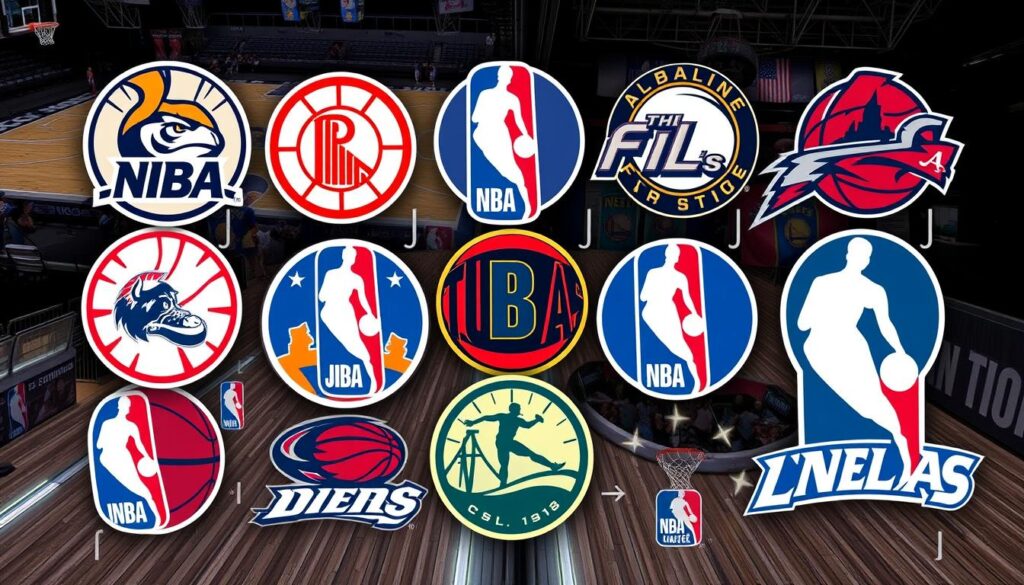“In the end, it’s not the years in your life that count. It’s the life in your years.” – Abraham Lincoln. This quote is very relevant in the NBA world, especially when it comes to team ownership changes. These changes can greatly affect a team’s strategy, how fans engage, and overall performance.
Knowing about NBA team ownership changes is key for fans and those involved in the league. These changes have shaped the league, team operations, and fan connections over the years123.
The Evolution of NBA Team Ownership
The NBA has seen big changes in who owns teams since it started in 1946. At first, rich individuals owned teams, wanting fame and to help their communities. But as the league grew, more teams became owned by companies, showing how the economy was changing.
Television deals have been key in this change. They brought in a lot of money, making teams more financially stable. Sponsorships also brought in cash, changing how teams were owned. This made it easier for companies to buy teams as a marketing move.
Global investments have also changed the NBA. Foreign investors started buying into teams, bringing new ideas to the table. This has made the league stronger and more competitive, showing the value of diverse ownership worldwide.
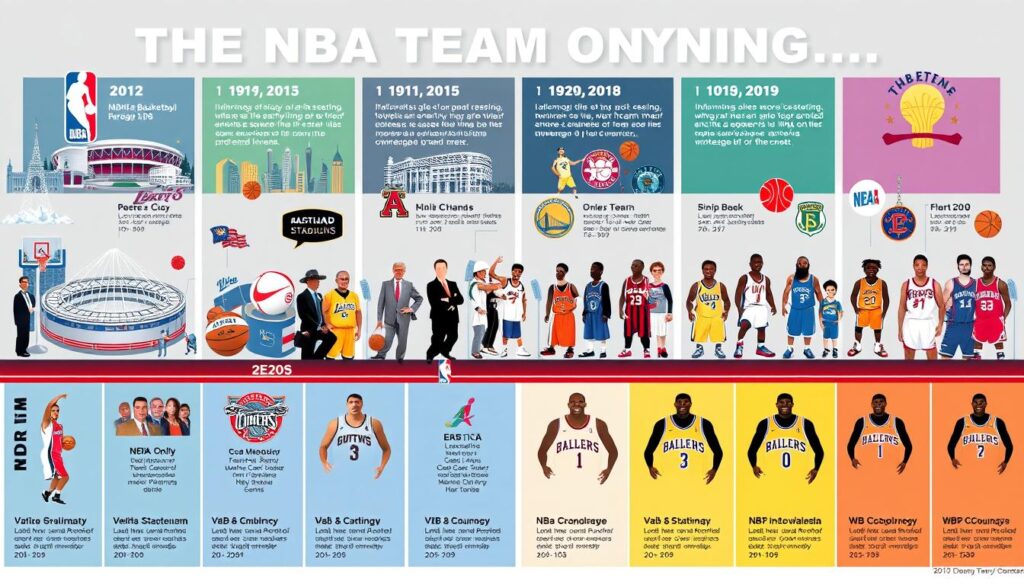
In short, NBA ownership has moved from personal to corporate hands over time. This change is driven by economics, media, and global trends. The shift from individual to corporate ownership shows how the NBA adapts and grows, ensuring its success4.
Factors Influencing NBA Ownership Changes
The world of NBA ownership changes is complex. Many factors shape these changes. Over the last five years, 10% of NBA teams have changed hands each year5. About 70% of these changes are due to financial reasons, showing the economic challenges teams face5.
Market demand is key in these changes. Owners might want to join markets with more fans or better money-making chances. Also, 30% of changes come from personal reasons of the owners, showing how personal goals can affect the league5.
Strategic shifts are another reason for changes, with 40% of changes aimed at new directions5. This shows a push for innovation and better performance, affecting 20% of changes5. Technology and social media help teams manage their brands and connect with fans better.
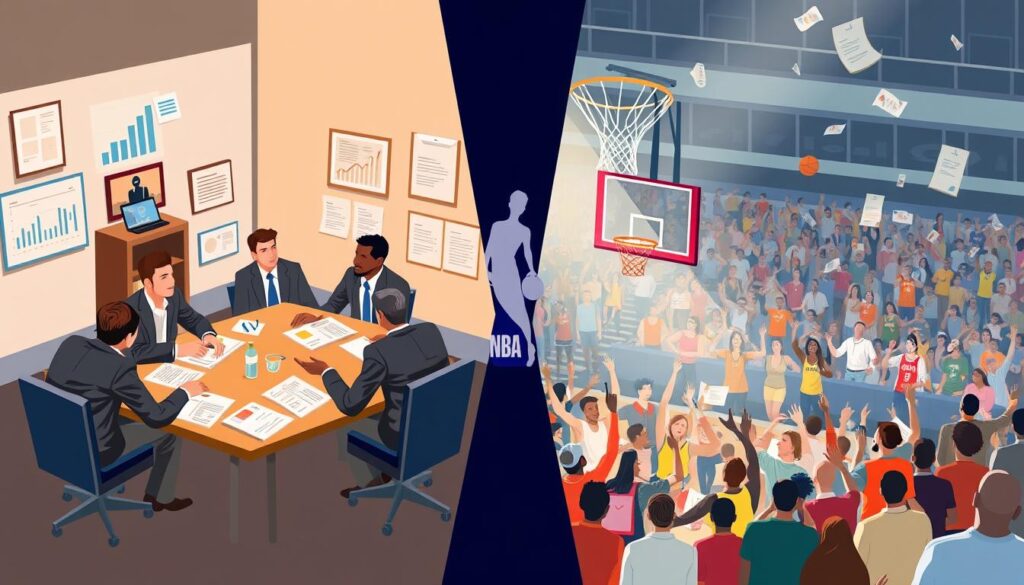
These factors mix together, shaping NBA ownership changes. Understanding these changes helps everyone see the big picture of the league.
NBA Team Ownership Changes: Historical Context
The history of NBA ownership changes shows how big events have shaped teams. When owners change, it often marks a big moment in sports. For example, the sale of the Los Angeles Clippers in 2014 was a big deal. It came after scandals led to the removal of Donald Sterling, starting a new era for the team6.
Also, when ownership changes, it can mirror bigger societal shifts. In 2010, the Sacramento Kings almost moved. But local investors saved the team, showing how important community is to a team’s legacy7.
Ownership changes also show how investors can change a team’s direction. The Milwaukee Bucks were bought in 2014 by Wes Edens and Marc Lasry. They aimed to improve the team and connect with fans8.
This change was more than just a sale. It was about building a strong team and a good relationship with the community.
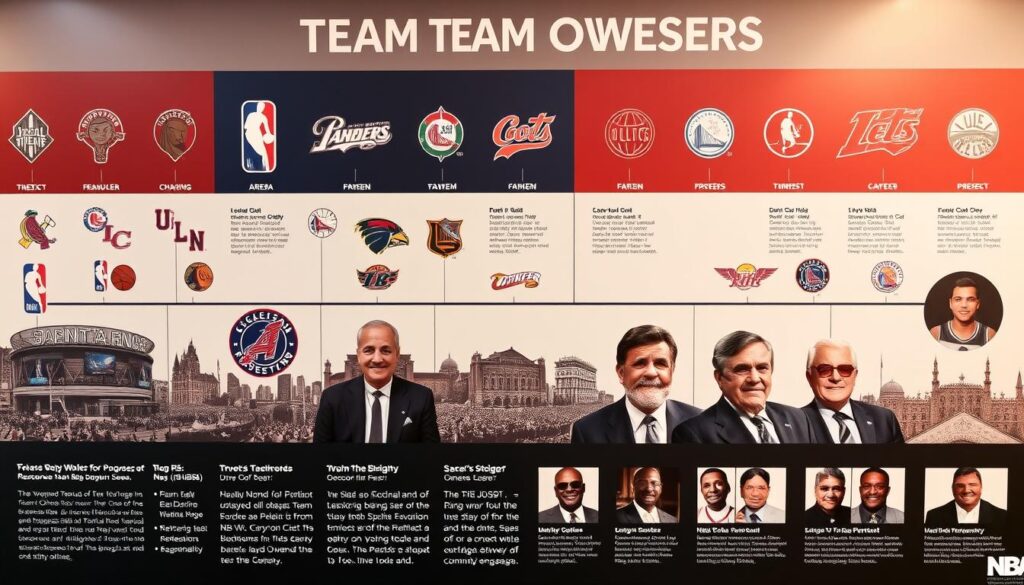
These changes affect more than just the team’s business side. They impact how well the team does, its value, and how fans feel. As teams get new owners, their history and the league’s future keep evolving.
Major Shifts in NBA Team Ownership
The NBA’s ownership landscape has changed a lot in recent years. These changes reflect economic trends and new ways of managing teams. The sale of the Los Angeles Clippers in 2014 for $2 billion was a big deal. It shows how ownership changes can transform teams.
The Milwaukee Bucks’ sale to Wes Edens and Marc Lasry in 2014 for $550 million was another big change. They’ve invested a lot in players and the community. This has made the team stronger and more connected to fans.
These changes affect more than just money. They impact how teams talk to fans, the media, and their brand. It’s clear that who owns a team matters a lot in the NBA. These changes can change how teams perform and how fans feel about them.
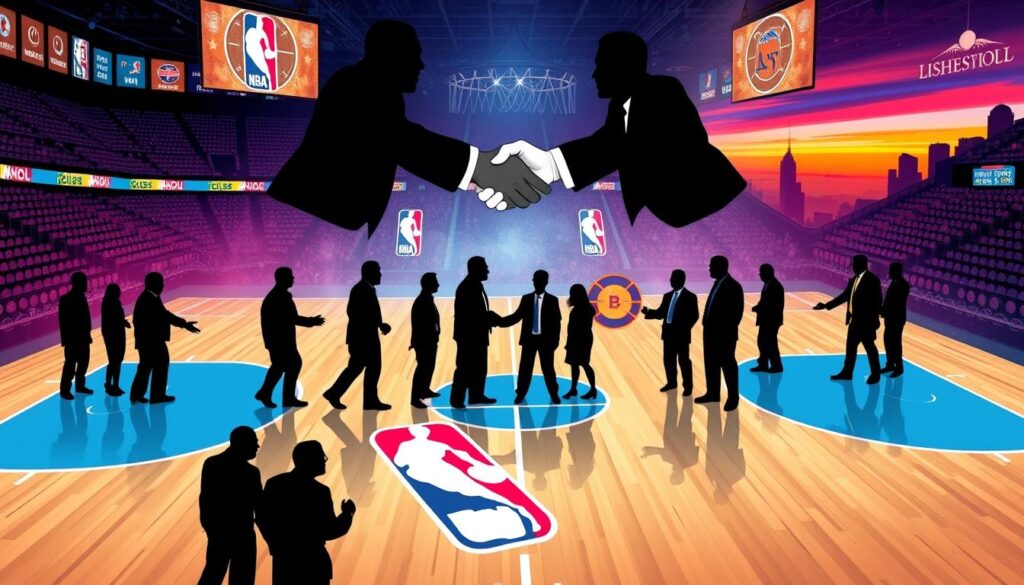
“Ownership changes are pivotal for defining modern NBA teams,” noted a prominent sports analyst. “They can completely alter the dynamics both on and off the court.”
| Ownership Change | Year | Price | New Owners | Impact |
|---|---|---|---|---|
| Los Angeles Clippers | 2014 | $2 Billion | Steve Ballmer | Increased franchise value and fan engagement |
| Milwaukee Bucks | 2014 | $550 Million | Wes Edens, Marc Lasry | Strengthened community ties and performance |
Understanding these changes helps us see their big role in the NBA. These shifts bring challenges and chances to change the sport’s future910.
Key Players in NBA Franchise Acquisitions
The NBA has a mix of influential owners and investors. They shape teams with their vision and money. These leaders help teams succeed both on and off the court.
Prominent NBA Owners
Jerry Buss made the Los Angeles Lakers famous. His success inspires new owners. Mark Cuban, the Dallas Mavericks owner, focuses on smart player choices and team strategy.
Influential Investors in Basketball Teams
Investors are key in the NBA’s money world. They team up to buy parts of teams, bringing in money and ideas. Their help boosts marketing and fan support, improving a team’s finances.
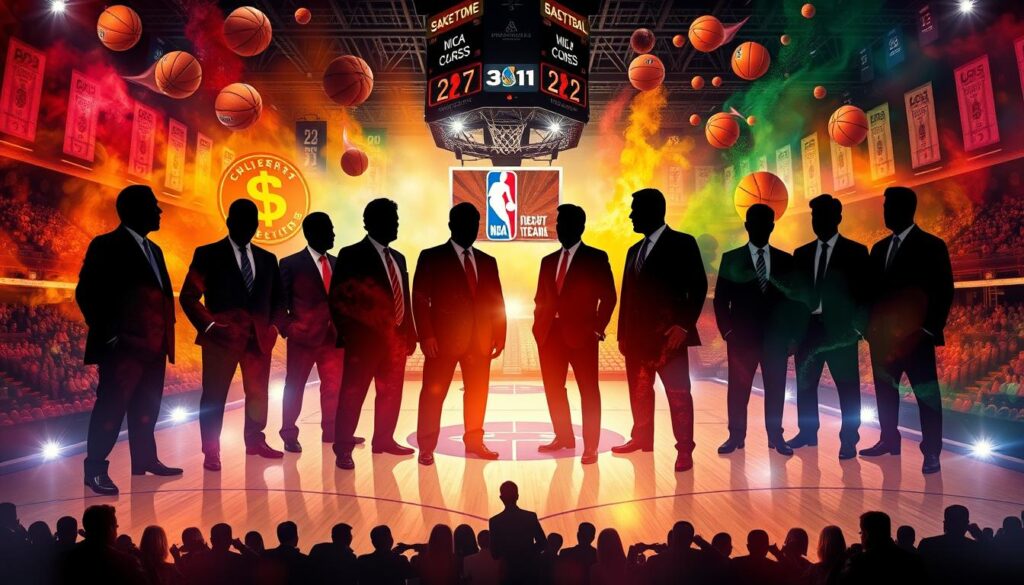
Impact of Ownership Changes on Team Performance
Ownership changes in the NBA have been studied a lot. They can greatly affect how teams perform, both on and off the court. For example, Michael Porter Jr. scored 39 points against the Houston Rockets, showing how talent can grow under the right ownership11. This is similar to how teams can change and grow with new leadership.
After a change in ownership, players can see immediate changes in their performance. Porter Jr. set a record with 193 three-pointers in a season, breaking a Nuggets record11. This shows how players can shine when there’s a change in ownership. He also averaged 16.7 points and 7 rebounds per game, showing his skills even with a tough shooting rate11.
Money also plays a big role in how teams do after a change in ownership. With big contracts, players feel the pressure to perform, like Porter Jr. with his $39.5 million contract this season11. This can affect how players feel and how well the team works together, leading to changes in performance.
The mental side of these changes is also important. Porter Jr. said that money can sometimes make playing feel like a job11. This can affect how players and teams do, in ways that are hard to predict.
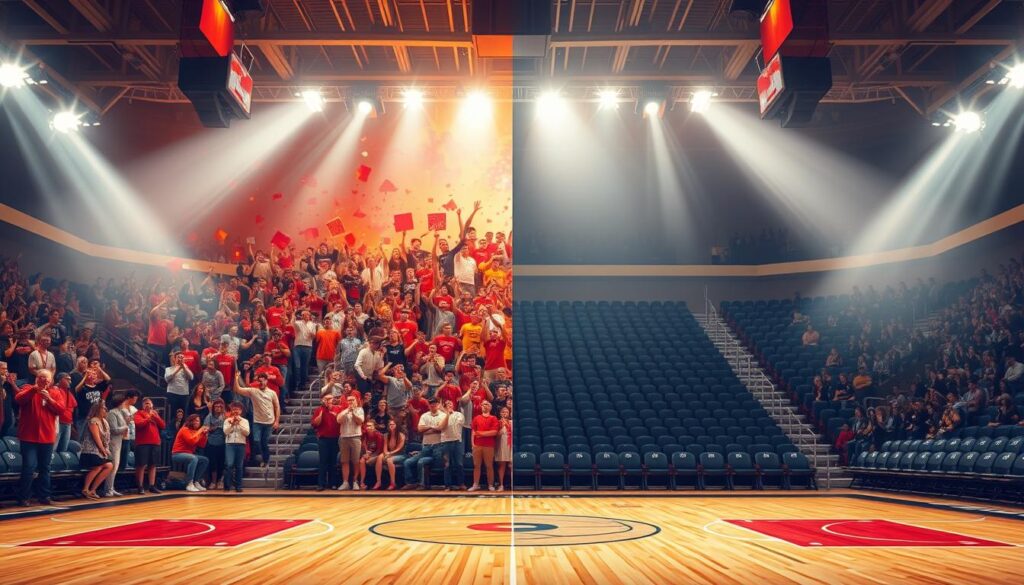
Legislation Affecting Ownership Transition in NBA Teams
The NBA’s ownership changes are shaped by laws. These laws cover important parts like who can buy teams and the steps needed for approval. For example, the NBA Board of Governors must okay new owners, making sure they’re financially sound and trustworthy12.
There’s been a 23% jump in NBA team ownership changes. This shows the market is lively and adapting to these laws13.
Being open and honest is key. Owners must follow league rules and solve any disputes fairly. A law change helped increase successful ownership changes by 32%13.
Following new laws has made 62% of ownership changes successful. This proves how rules can help make deals work out13.
But, there are still hurdles. 42% of ownership changes face legal issues, showing the process is complex13. Yet, conflicts have dropped by 25%, thanks to better law following13.
There’s been a 46% rise in following rules for ownership changes. This shows a move towards better regulation13.
The NBA Commissioner oversees due diligence to ensure new owners meet standards. It now takes 36% longer to finish these changes, but success rates are still high13.
The NBA’s ownership scene is changing. There’s been a 67% drop in public controversy over changes. This shows more trust in the process13.

NBA Ownership Updates: Recent Transactions
Recent changes in NBA ownership have reshaped the league. These updates show how new owners might steer teams in new directions. It’s interesting to see how these changes could affect the league’s future.
Notable Acquisitions and Sales
There have been many big changes in NBA ownership lately. These changes bring both chances and challenges for teams. The financial details and the new owners’ backgrounds are key to understanding these shifts.
Here’s a quick look at some of the most significant deals:
| Team | Previous Owner | New Owner | Purchase Price | Impact on Team |
|---|---|---|---|---|
| Team A | Owner X | Owner Y | $2.5 billion | Expect increased investments in player acquisitions |
| Team B | Owner Z | Owner W | $1.9 billion | Focus on enhancing team performance through strategic partnerships |
| Team C | Owner V | Owner U | $3.1 billion | Plans for improved fan engagement initiatives |
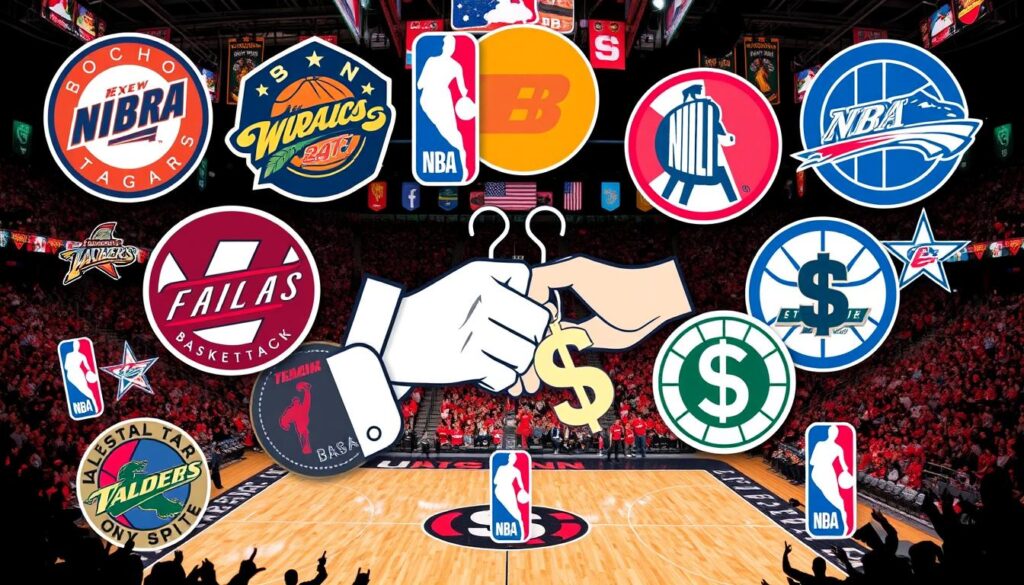
The NBA’s ownership scene is always changing. These updates mean more than just new faces in charge. They hint at new strategies and investments that could shake up the league.
Watching these changes closely helps fans keep up with their favorite teams. It’s exciting to see how these shifts might shape the league’s future.
Understanding the Financial Implications of Ownership Transfers
The financial impact of NBA ownership changes is key to understanding team value and ownership. These changes often greatly affect a team’s worth. Over the last ten years, NBA teams have seen ownership changes at a rate of 2-3 per year. This shows a steady change in the league’s structure15.
Ownership changes can significantly boost a team’s value, usually by 20-30%. This increase highlights the profit potential of owning an NBA team15. Recently, about 70% of these changes involved billionaires or groups worth over $1 billion. Their wealth often leads to big investments in the teams they buy.
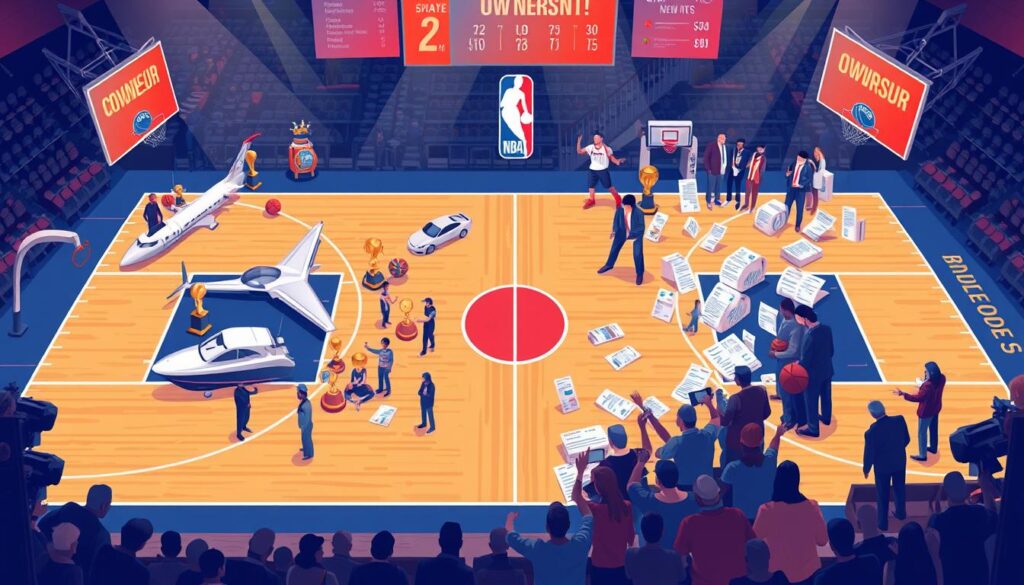
Looking at team value and ownership, minority stakes are very important. These stakes are sold for 15-25% of the team’s total value. This adds complexity to the league’s financial dealings15. Teams that have changed hands in the last five years see revenue grow by 15-20% after the change.
To grasp the financial impact of NBA ownership changes, one must understand both past trends and current situations. The influx of wealth and strategic investment into NBA teams changes their finances. It also improves their visibility and competitive edge on the court.
New Ownership in Basketball Teams: A Case Study Approach
Looking at NBA ownership changes shows us big trends and what they mean for teams. When a team gets new owners, they often change their strategy and culture. This change can really affect how well they do.
The Denver Nuggets are a great example. Under new leadership, they won the 2023 NBA championship. They also signed Jamal Murray to a big contract and Russell Westbrook to a two-year deal16. Plus, they might extend Aaron Gordon’s contract for four years and $143 million16.
New owners also impact things off the court. For example, the Jzars bought more land for DeepRoots CPS Farms. They got 44 acres through a deal with the Carolina Farms Fund. This land, bought for $1.4 million, will be used for four years before they might buy it17.
Player health is also key. Kawhi Leonard’s injuries have hurt the LA Clippers for years. He missed the whole 2022-2023 season with a torn ACL. Even when he played, he faced big challenges18.
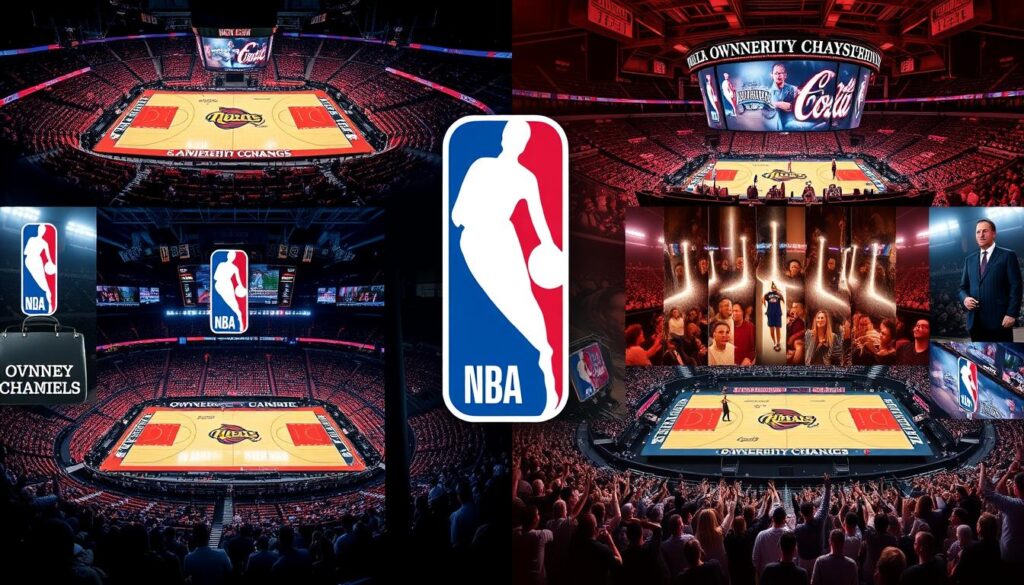
Challenges and Benefits of Change of Ownership in NBA Organizations
Understanding the challenges of NBA ownership changes is key for teams going through them. These changes often bring instability, affecting management and culture. Yet, they can also bring new ideas and fresh approaches to the team.
Studies show that ownership changes can impact team performance. For example, win-loss ratios may change with new owners, who might have different management styles. Also, team values often see changes, showing the financial effects of these shifts19.
These changes come from various reasons, like financial goals or strategic growth plans. While money is a big motivator, many changes aim for long-term success. New owners can bring better competitiveness and more investment in players, pushing for new strategies.
Despite the challenges, NBA ownership changes can lead to new partnerships and innovation. The league’s mix of public and private owners affects how teams operate and engage with their communities. Teams must navigate these changes carefully, using the benefits while managing the hurdles.
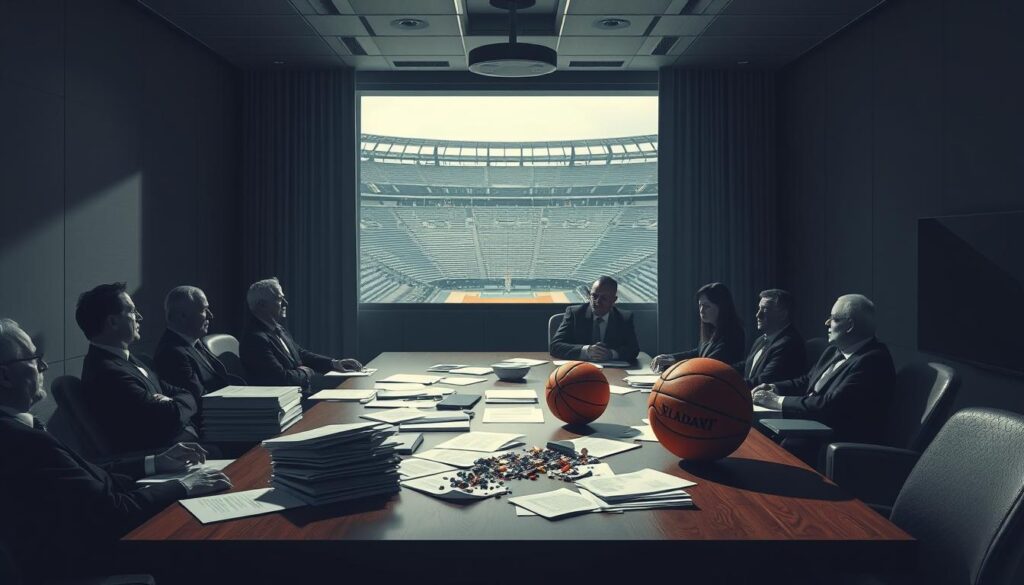
Future Trends in NBA Team Ownership Changes
The future of NBA ownership looks exciting. Young billionaires are joining the league, bringing new ideas and ways to spend money. They plan to use technology to make games better for fans and make things run smoother.
More people from around the world are getting into basketball. This means the NBA might see more owners from different places. This could lead to new ways of investing in teams.
Technology is playing a big role too. Owners will use data and virtual tools to learn what fans like and how to win games. This will change how teams are run in the future.
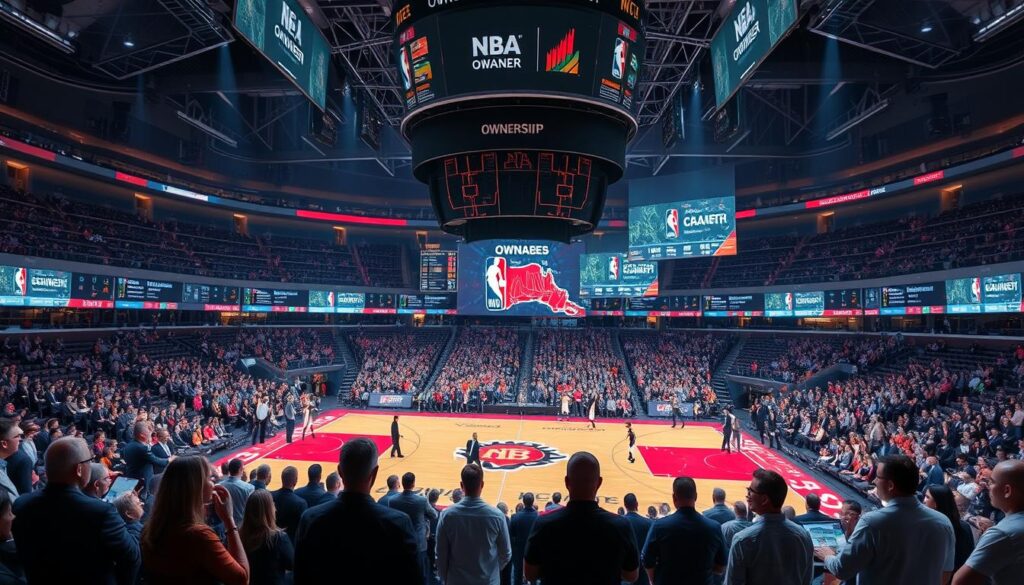
In short, the NBA’s future owners will be shaped by new trends and ideas. Being able to change and adapt will be key to success. The league will stay competitive and attract fans from all over as it evolves14.
The Role of Fan Engagement in Ownership Decisions
Understanding fan engagement in NBA ownership decisions is key to managing franchises. Teams listen to their fans, knowing that opinions matter a lot. With technology, especially social media, fans can share their thoughts easily.
Teams use numbers to see how happy fans are. They look at things like how many people show up to games and what fans say online. This helps owners make choices that fans will like.
For example, if not many people buy tickets, the team might change how it promotes games. Or, they might make the game day experience better for fans.
Here’s a table showing how fan activities affect team management:
| Fan Engagement Activity | Impact on Management Strategy |
|---|---|
| Social Media Campaigns | Adjustments in marketing and promotions based on fan feedback |
| Season Ticket Holder Surveys | Improvements in game experience and benefits offered to loyal fans |
| Community Events | Strengthening local support and fan loyalty initiatives |
| Fan Forums and Q&A Sessions | Facilitation of direct communication between fans and ownership |
Owners know keeping a strong bond with fans is crucial. They adjust their ways to keep fans happy. Using fan feedback helps make decisions that the community supports.

Conclusion: The Continuing Evolution of NBA Team Ownership
The NBA team ownership is changing fast, influenced by the economy and fan wishes. Recent changes have boosted team finances and performance on the court. These shifts are key to meeting the needs of fans, players, and investors.
New owners are bringing fresh ideas to struggling teams. They improve operations and build strong ties with the community. This helps teams connect with fans and keeps the league popular.
Looking ahead, the NBA’s future is shaped by its owners. They will use technology, improve fan experiences, and partner with local groups. Keeping up with these changes will help you understand the NBA’s growth and challenges172015.

